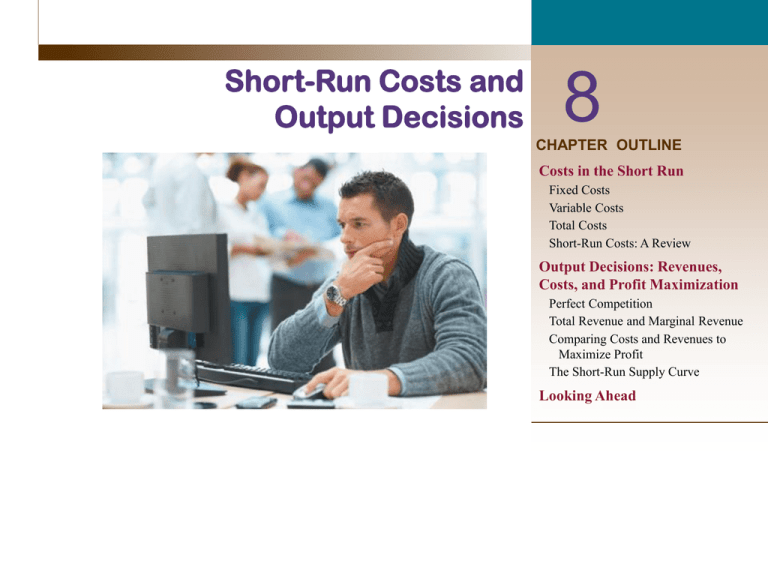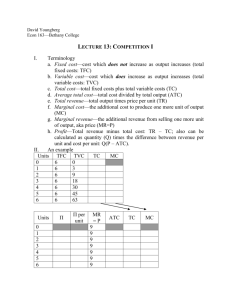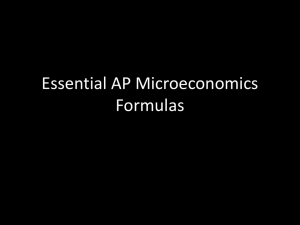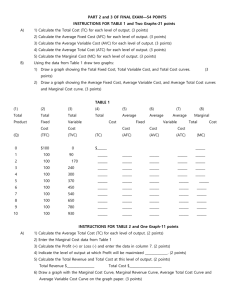Chapter 8 - Costs of Production
advertisement

Short-Run Costs and
Output Decisions
8
CHAPTER OUTLINE
Costs in the Short Run
Fixed Costs
Variable Costs
Total Costs
Short-Run Costs: A Review
Output Decisions: Revenues,
Costs, and Profit Maximization
Perfect Competition
Total Revenue and Marginal Revenue
Comparing Costs and Revenues to
Maximize Profit
The Short-Run Supply Curve
Looking Ahead
In their quest for profits, firms make three specific decisions involving their
production.
FIGURE 8.1 Decisions Facing Firms
Costs in the Short Run
fixed cost Any cost that does not depend on the firms’ level of output. These
costs are incurred even if the firm is producing nothing. There are no fixed
costs in the long run.
variable cost A cost that depends on the level of production chosen.
total cost (TC) Total fixed costs plus total variable costs.
TC = TFC + TVC
1
A production function and Fixed Costs
Number
of workers
Output
(quantity of cookies
produced per hour)
0
1
2
3
4
5
6
0
50
90
120
140
150
155
Marginal
product
of labor
50
40
30
20
10
5
Cost of
factory
Cost of
workers
Total cost of inputs
(cost of factory +
cost of workers)
$100
100
100
100
100
100
100
$0
10
20
30
40
50
60
$100
110
120
130
140
150
160
4
Fixed Costs
Total Fixed Cost (TFC)
total fixed costs (TFC) or overhead The total of all costs that do not change
with output even if output is zero. (Typically Capital)
TABLE 8.1 Short-Run Fixed Cost (Total and
Average) of a Hypothetical Firm
(1)
q
0
1
2
3
4
5
(2)
TFC
$100
100
100
100
100
100
(3)
AFC (TFC/q)
$
100
50
33
25
20
Average Fixed Cost (AFC)
average fixed cost (AFC) Total fixed cost divided by the number of units of
output; a per-unit measure of fixed costs.
AFC
TFC
q
FIGURE 8.2 Short-Run Fixed Cost (Total and Average) of a Hypothetical Firm
Average fixed cost is simply total fixed cost divided by the quantity of output.
As output increases, average fixed cost declines because we are dividing a fixed
number ($1,000) by a larger and larger quantity.
spreading overhead The process of dividing total fixed costs by more units of
output. Average fixed cost declines as quantity rises.
1
A production function and variable costs
Number
of workers
Output
(quantity of cookies
produced per hour)
Marginal
product
of labor
0
1
2
3
4
5
6
0
50
90
120
140
150
155
50
40
30
20
10
5
Cost of
factory
Cost of
workers
Total cost of inputs
(cost of factory +
cost of workers)
$100
100
100
100
100
100
100
$0
10
20
30
40
50
60
$100
110
120
130
140
150
160
7
2
Caroline’s production function and total-cost curve
Quantity
of Output
(cookies
per hour)
(a) Production function
Production
function
$90
160
80
140
70
120
60
100
50
80
40
60
30
40
20
20
10
0
1
2
3
4
5
(b) Total-cost curve
Total
Cost
6 Number of
Workers Hired
0
Total-cost curve
20
40
60
80 100 120 140 160 Quantity
of Output
(cookies per hour)
The production function in panel (a) shows the relationship between the number of workers hired and the quantity of
output produced. Here the number of workers hired (on the horizontal axis) is from the first column in Table 1, and the
quantity of output produced (on the vertical axis) is from the second column. The production function gets flatter as the
number of workers increases, which reflects diminishing marginal product. The total-cost curve in panel (b) shows the
relationship between the quantity of output produced and total cost of production. Here the quantity of output produced
(on the horizontal axis) is from the second column in Table 1, and the total cost (on the vertical axis) is from the sixth
8
column. The total-cost curve gets steeper as the quantity of output increases because of diminishing marginal product.
Marginal Cost (MC)
marginal cost (MC) The increase in total cost that results from producing 1
more unit of output. Marginal costs reflect changes in variable costs.
TABLE 8.3 Derivation of Marginal Cost from Total Variable Cost
Units of Output
Total Variable Costs ($)
0
1
2
3
0
20
38
53
Marginal Costs ($)
20
18
15
The Shape of the Marginal Cost Curve in the Short Run
FIGURE 8.4 Declining Marginal Product Implies That Marginal Cost Will Eventually Rise
with Output
In the short run, every firm is constrained by some fixed factor of production.
A fixed factor implies diminishing returns (declining marginal product) and a limited capacity to
produce. As that limit is approached, marginal costs rise.
In the short run, every firm is constrained by some fixed input that (1) leads to diminishing
returns to variable inputs and (2) limits its capacity to produce. As a firm approaches that
capacity, it becomes increasingly costly to produce successively higher levels of output.
Marginal costs ultimately increase with output in the short run.
Graphing Total Variable Costs and Marginal Costs
FIGURE 8.5 Total Variable Cost and
Marginal Cost for a Typical Firm
Total variable costs always increase with
output.
Marginal cost is the cost of producing each
additional unit.
Thus, the marginal cost curve shows how
total variable cost changes with single-unit
increases in total output.
slope of TVC
TVC TVC
TVC MC
Δq
1
Graphing Average Variable Costs and Marginal Costs
FIGURE 8.6 More Short-Run
Costs
When marginal cost is below
average cost, average cost is
declining.
When marginal cost is above
average cost, average cost is
increasing.
Rising marginal cost intersects
average variable cost at the
minimum point of AVC.
Total Costs
FIGURE 8.7 Total Cost = Total Fixed Cost + Total Variable Cost
Adding TFC to TVC means adding the same amount of total fixed cost to every level of total
variable cost.
Thus, the total cost curve has the same shape as the total variable cost curve; it is simply
higher by an amount equal to TFC.
Average Total Cost (ATC)
average total cost (ATC) Total cost
divided by the number of units of
output.
TC
ATC
q
ATC AFC AVC
FIGURE 8.8 Average Total Cost =
Average Variable Cost + Average
Fixed Cost
To get average total cost, we add
average fixed and average variable
costs at all levels of output.
Because average fixed cost falls
with output, an ever-declining
amount is added to AVC.
Thus, AVC and ATC get closer
together as output increases, but
the two lines never meet.
The Relationship Between Average
Total Cost and Marginal Cost
The relationship between average
total cost and marginal cost is
exactly the same as the
relationship between average
variable cost and marginal cost.
If marginal cost is below average
total cost, average total cost will
decline toward marginal cost. If
marginal cost is above average
total cost, average total cost will
increase. As a result, marginal
cost intersects average total cost
at ATC’s minimum point for the
same reason that it intersects the
average variable cost curve at its
minimum point.
What Does a Firm Do?
• Firm’s Objective
– Firms seek to maximize profits
• Profits = Total Revenues minus Total Costs
• Choose Q such that Max {TR(Q*) –TC{Q*}
• Total revenue
– Revenue received from sale of its output
• Total cost
– Market value of the inputs a firm uses in
production
16
• Total revenue = P*Q
2-17
– Revenue received from sale of its output
– Market price for the good
– Perfect Comp -> P-taker
– Firm’s output decision does not affect
price: P does not depend on Q
– Revenues only affected then by quantity
supplied/produced
– What can be produced profitably at the
given market price?
• Total cost
– Market value of the inputs a firm uses in
production
– Cost = price(input 1)*Q(input 1) + … +
price(input n)* Q(input n)
𝑛
– C(Q) = 𝑖=1 𝑃𝑖Qi
2-18









